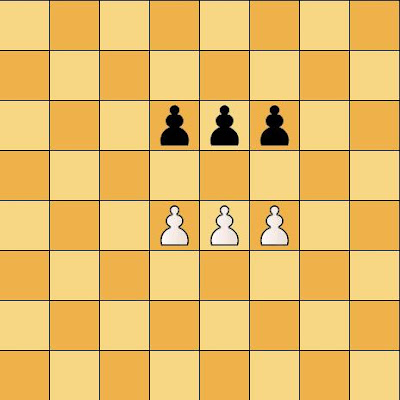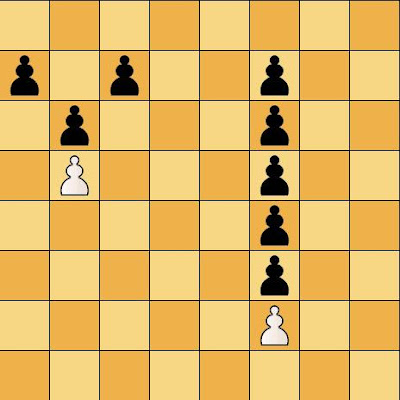emagdne ehT spelled backwards
To me, a middlegame position is a bunch of positional topics which have almost no relation at all. They just happen to me in a game. My contemplations in the past about piece activity has provided some sort of cohesy. Of course there must be some hierarchy in the characteristics by which a position is evaluated, but sofar this structure remained obfuscated to me. In order to find out, I start at the very end of the game and work my way back to the middlegame, or maybe even to the opening. I will focus on how matters are interwoven. Maybe it will take me more than one post, I don't know, but I'm not going to hurry. I hope to be able to find the "ideal line" of the game. Which things should be evaluated first. Of course there are often shortcuts in a position due to accidents, like winning a piece or mating a king. But assuming that both opponents are able to avoid such accidents (or don't recognize them as they occur), what should you look for and why? And how are the topics logically related?
There we go.
To get a clear picture of every influence solely, we must isolate it's effect as much as possible. The first thing I'm asking myself is what influences play a role for the pawns alone, if the effect of the kings is taken away from them. See the following diagram.
Diagram 1.

The pawnrace.
What you see above is the pawnrace.
Decisive parameters:
Diagram 2.

The blockade.
In this position there is only one outcome possible.
Parameter:
Diagram 3.

Zugzwang.
Parameters:

Breakthrough.
This is the same position as diagram 1. By sacrificing a pawn you can create a passer. You lure away the blockading or restraining pawn, thus freeing the road to promotion for another pawn of yours. The interesting thing is that you can do that alone by freeing the road for your opponent too, thus starting a pawnrace similar to the one on diagram 1. Hence the same parameters play a role:

One stops two.
Capablanca teached us that it is not the amount of pawns that count, but the amount of pawns that you can prevent to promote. In the diagram above the 2 white pawns are controlling 8 pawns of black.
Logically this must be your startpoint at all times when evaluating an endgame or even a middlegame position: imagine that all pieces and the kings are gone and that only the pawns are left. What would be the outcome? Only very few parameters have to be taken into account to answer that question. Next post: what is the influence of the kings?
There we go.
To get a clear picture of every influence solely, we must isolate it's effect as much as possible. The first thing I'm asking myself is what influences play a role for the pawns alone, if the effect of the kings is taken away from them. See the following diagram.
Diagram 1.

The pawnrace.
What you see above is the pawnrace.
Decisive parameters:
- De road to promotion must be free.
- The distance which each pawn already has traveled.
Diagram 2.

The blockade.
In this position there is only one outcome possible.
Parameter:
- The road to promotion is blocked.
Diagram 3.

Zugzwang.
Parameters:
- The road to promotion is restrainted.
- There are no other moves.
- You have to move but you would rather not.

Breakthrough.
This is the same position as diagram 1. By sacrificing a pawn you can create a passer. You lure away the blockading or restraining pawn, thus freeing the road to promotion for another pawn of yours. The interesting thing is that you can do that alone by freeing the road for your opponent too, thus starting a pawnrace similar to the one on diagram 1. Hence the same parameters play a role:
- De road to promotion must be free.
- The distance which each pawn already has traveled.

One stops two.
Capablanca teached us that it is not the amount of pawns that count, but the amount of pawns that you can prevent to promote. In the diagram above the 2 white pawns are controlling 8 pawns of black.
Logically this must be your startpoint at all times when evaluating an endgame or even a middlegame position: imagine that all pieces and the kings are gone and that only the pawns are left. What would be the outcome? Only very few parameters have to be taken into account to answer that question. Next post: what is the influence of the kings?
Pawn Endings for Dummies What a beautiful and simple way to explain the essence of pawn ending structures. Just being able to see the pawns without having to think about the king gives the student a clearer picture of the basics.
ReplyDeleteThis approach strips the end down to the basic components, when one understands those basic elements then it's easier to introduce the role of the king or what other pieces might be in the ending.
Nice explanation. Seeing the theoretical end from the middle or the opening is an advantage of studying endgames. Of course, sometimes a pawn structure change that helps you in a pawn endgame will cause you grief in a strategic endgame (R+B vs R+N) or middlegame. Also, when adding the kings, note that some positions (for example, 2 pawns vs 1 pawn configurations) that are trivial without the kings become very interesting with them!
ReplyDeleteGood rule of thumb, to imagine all nonpawns gone from the board. Very helpful simplification!
ReplyDeleteIt is just amazing to see you come up with another fundamental approach. There is a lot to be said about the backwards approach, and I am sure that Capablanca would have applauded it.
ReplyDeleteIt does raise some questions however. But it would be premature to raise them before you had the opportunity to lay out the complete story.
Please give us more of this. This first post is already very promising.